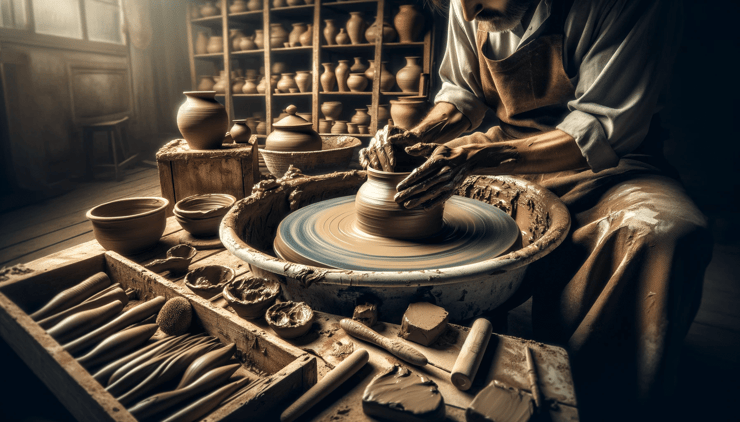🕓 2023/12/30
#文化
Detailed Explanation of Pottery's History and Experience

Table of Contents
- 1. What is Pottery?
- 2. The History of Pottery
- 3. Pottery Tools
- 4. Types of Pottery
- 5. Places to Experience/Feel Pottery
Introduction
Japanese pottery is a traditional art form with a history of more than a thousand years. This article explores the basics of pottery, its history, types, and places where you can experience it in detail.
1. What is Pottery?
Pottery is a craft that involves shaping clay and firing it to create ceramics and porcelain. Hand skills and creativity play an important role, producing a wide range of items from practical goods to artistic works.
2. The History of Pottery
Japanese pottery has a long history with distinct characteristics in each era.
◆ Jomon Period
- The Jomon pottery, the beginning of Japanese ceramics, dates back to approximately 16,500 years ago, discovered at the Odai Yamamoto site in Aomori Prefecture.
◆ Kofun Period
- Characteristic: Production of Haniwa (terracotta clay figures) began, with highly decorative vessels made as burial objects.%20and%20decorative%20pottery%20used%20as%20grave%20goods.%20The.png?width=426&height=244&name=DALL%C2%B7E%202023-12-29%2023.18.36%20-%20A%20historical%20scene%20from%20the%20Kofun%20period%20in%20Japan%2c%20focusing%20on%20the%20production%20of%20Haniwa%20(clay%20figures)%20and%20decorative%20pottery%20used%20as%20grave%20goods.%20The.png)
◆ Nara Period
- New Technology: Glazed pottery appeared, showing influences from China and Korea.
- Characteristic: "Nara Sansai" featured vibrant green, brown, and white glazes.
◆ Heian Period
- Technological Advancement: Ash glazed pottery emerged. Techniques shifted from reduction firing to oxidation firing at high temperatures.
- Daily Use Items: Production of everyday items like tea bowls began. 
◆ Medieval (Kamakura & Muromachi Periods)
- Regional Characteristics: Six ancient kilns became prominent in pottery production. Seto was known for glazed pottery, while other areas mainly produced unglazed, fired pottery. 
◆ Azuchi-Momoyama Period
- Influence of Tea Ceremony: Popularity of tea utensils with glazes like Seto black, Oribe, and Shino. Techniques spread to Kyoto, giving birth to Raku ware.
- Beginning of Porcelain: Production of porcelain began with the arrival of Korean potters.
◆ Edo Period
- Porcelain Development: Porcelain production accelerated, with centers like Imari and Arita. Overglaze enameling techniques also developed.
◆ Meiji Period
- Technological Innovation and Modernization: Introduction of techniques by German Gottfried Wagener significantly evolved Japanese pottery.
Thus, Japanese pottery, starting from the Jomon period, has developed a variety of techniques and styles up to the present day.
3. Pottery Tools
Various tools are used in pottery, each playing a crucial role in the creation of works.
1. Clay
Naturally occurring, with properties like fire resistance, fine texture, and ease of shaping when wet. %2c%20used%20in%20the%20shaping%20process%20of%20pottery.%20The%20image%20should%20display%20a%20typical%20potters%20wheel%2c%20capable%20of.png?width=481&height=275&name=DALL%C2%B7E%202023-12-29%2023.17.17%20-%20A%20realistic%20photo%20of%20a%20potters%20wheel%20(roku-ro)%2c%20used%20in%20the%20shaping%20process%20of%20pottery.%20The%20image%20should%20display%20a%20typical%20potters%20wheel%2c%20capable%20of.png)
2. Glaze
Used for coating the surface of ceramics, acting as a thin glass-like film. Types include ash glaze made from wood ash or plants, and colored glazes made from minerals.。
3. Kiln
A structure used for firing shaped clay. Evolved from outdoor pit firing using wood, kilns are classified by purpose (biscuit firing, glost firing) and heat source (wood-fired, coal-fired, oil-fired, gas-fired, electric).

4. Pottery Wheel
A rotatable platform used for shaping. Clay is centered and shaped while rotating, ideal for creating circular vessels and tableware.。
%2c%20used%20in%20the%20shaping%20process%20of%20pottery.%20The%20image%20should%20display%20a%20typical%20potters%20wheel%2c%20capable%20of.png?width=471&height=269&name=DALL%C2%B7E%202023-12-29%2023.17.17%20-%20A%20realistic%20photo%20of%20a%20potters%20wheel%20(roku-ro)%2c%20used%20in%20the%20shaping%20process%20of%20pottery.%20The%20image%20should%20display%20a%20typical%20potters%20wheel%2c%20capable%20of.png)
5. Cutting Wire
Used for cutting clay, especially useful for slicing off required amounts from larger blocks.

6. Sculpting Tools
Used for detailed work and engraving designs. Various shapes are available for different purposes.

7. Sponge:
Used for smoothing the surface of shaped pieces and removing debris.

These tools are fundamental in pottery-making, each significantly impacting the finish of the work.
4. Types of Pottery
◆ Shigaraki Ware
- Feature: Characterized by its translucent glass-like glaze. Known for its natural texture and famous for Tanuki (raccoon dog) statues.
◆ Bizen Ware
- Feature: Often unglazed, known for its unique earthy taste and hardness. Natural colors emerge from long, high-temperature firing.
◆ Kutani Ware
- Feature: Known for its bright colors and detailed painting. Famous for designs of flowers, birds, and landscapes in gold and colored paintings.
These are representative types of Japanese pottery, each with its unique beauty and techniques.
5. Places to Experience and Feel Pottery
1、Hakone Craft House (Kanagawa Prefecture)
- Located in the Hakone area, this facility offers pottery experiences.
2、Zuiho Kiln Kyoto Kiyomizu Store (Kyoto Prefecture)
- A pottery studio in Kyoto's Kiyomizu area, offering experiences in traditional Kyoto and Kiyomizu ware using electric pottery wheels.
3、International Street Experience Workshop TRIP CRAFT NAHA (Okinawa Prefecture)
- Located on Okinawa's International Street, this workshop offers various craft experiences, including pottery.
4、Atami Craft Workshop (Shizuoka Prefecture)
- Situated in Atami City, this facility offers pottery experiences for beginners to experienced individuals.。
